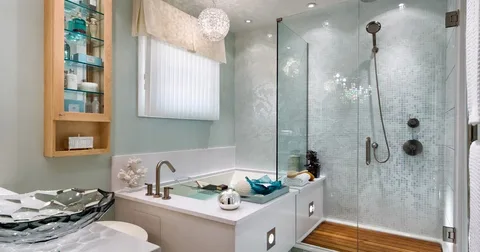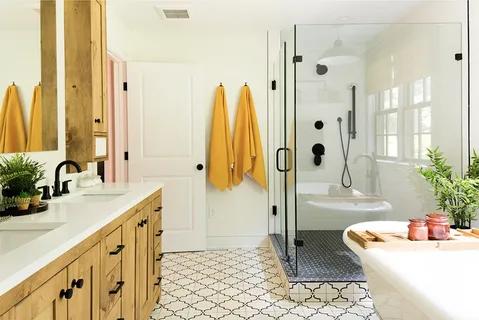The era of smart homes is upon us, and nothing exemplifies this more than cutting-edge ventilation systems. One such modern invention that’s shaking up the ventilation landscape is the HRV bathroom fan. This innovative ventilation solution optimises your home’s airflow and increases energy efficiency. But how exactly does it work? What benefits does it offer? Let’s take a closer look.
Understanding Hrv Bathroom-Fans
HRV, or Heat Recovery Ventilation, signifies a ventilation system that swaps out the stale indoor air with fresh, filtered outdoor air. Specifically designed to ventilate smaller, moist areas such as bathrooms, HRV fans have a unique edge over conventional bathroom fans. They transfer heat from the outgoing stale air to the incoming fresh air. This process ensures a consistent indoor temperature and prevents unnecessary energy loss.
This way, they help maintain a comfortable indoor climate while optimising energy consumption. Imagine allowing your home to ‘breathe’ — exhaling stale, damp air and inhaling fresh, filtered air while retaining the heat. By functioning in this advanced manner, HRV fans dramatically enhance the overall ventilation efficiency in your home while contributing to energy conservation.
Ventilation through Bathroom HRV
The unique design of a bathroom-HRV system ensures optimal ventilation that strikes the perfect balance between indoor air quality and energy efficiency. The HRV system operates by consistently extracting stale air from damp areas, like your bathroom, and replacing it with fresh air drawn from outside. This cyclical process is crucial in preventing the buildup of excess moisture and the potential growth of mould or mildew.
As the bathroom HRV system draws in the fresh outdoor air, it passes through a specialised heat exchanger or Recuperator. Here, the heat from the outgoing stale air is transferred to the incoming cool air. This intelligent mechanism facilitates effective ventilation and recovers the heat energy that would otherwise be lost – a feature that sets HRV systems apart from traditional bathroom fans.
One of the key benefits of a bathroom-HRV system is that it does not simply vent out stale air but also infuses your bathroom with fresh, filtered air. This ongoing air exchange cycle helps maintain a comfortable and consistent temperature in the bathroom without compromising energy efficiency. When in operation, the HRV system expels excess moisture from the bathroom, reducing condensation on your mirrors and windows.
How Hrv Improves Air Quality
The HRV bathroom-fan system is pivotal in enhancing indoor air quality. With a continual cycle of expelling stale, polluted air and importing fresh air, it actively maintains a healthy and clean atmosphere within your home. What sets the HRV system apart is its ability to reduce indoor pollutants.
As it consistently circulates fresh air into your home, it dilutes and pushes out potential allergens, dust particles, and airborne chemicals that could compromise the air quality. This rigorous filtration process significantly reduces pollutants, ensuring a healthier environment for you and your family to live in. Therefore, those prone to respiratory issues or allergies can greatly benefit from the cleaner air an HRV system provides.
By controlling the humidity levels, the HRV system also prevents the buildup of moisture that can often lead to the growth of mould and mildew – further contributing to the cleanliness and safety of your indoor air. An HRV system does more than ventilate your home; it actively ensures that your air is as pure and healthy as possible.
The Mechanism of HRV Heat Transfer System
The core of the HRV system’s operation lies in the heat transfer mechanism. As mentioned, the HRV system exchanges stale indoor air with fresh outdoor air. However, it doesn’t stop there. During this process, a vital function called heat recovery occurs. Here’s how it works: when the stale indoor air, warmed from your home’s heating system, is expelled outside, it passes through the heat exchanger in the HRV system.
Simultaneously, the fresh, outdoor air, which is generally cooler, is drawn into the system. As these two airstreams pass each other within the heat exchanger, the heat from the outgoing air is transferred to the incoming air. This is done without direct contact or mixing the two airstreams, preventing contamination. This ingenious process of heat recovery allows the HRV heat transfer system to maintain a stable, comfortable indoor temperature while preventing energy waste.
The HRV system, therefore, acts like an environmental steward, retaining the warmth within your home while promoting a continuous cycle of fresh air circulation. By integrating a heat transfer mechanism into the ventilation process, the HRV system balances energy efficiency and air quality, underscoring its innovative design.
Benefits of Heat Recovery Ventilation
Heat Recovery Ventilation (HRV) systems have numerous advantages extending beyond energy conservation and improved air quality. These systems are key in mitigating condensation, a common issue in moist areas like bathrooms. This can be a significant advantage, considering that unchecked condensation can lead to the growth of mould and mildew, affecting the health of the occupants and damaging the structure of your home.
Moreover, HRV systems contribute to maintaining a balanced humidity level inside your home. This benefits your health and the preservation of your home’s structure. High humidity can often lead to the deterioration of building materials, but with an HRV system, this risk is greatly reduced. The continuous introduction of fresh air by the HRV system can also lead to noticeable improvements in your overall comfort and well-being.
The constant supply of oxygen can reduce fatigue and enhance concentration. HRV systems can also contribute to noise reduction. Creating a seal against outdoor noise can make your indoor environment quieter and more peaceful. Hence, installing an HRV bathroom-fan can bring many benefits, making your home more comfortable, healthier, and energy-efficient.
Heat Recuperator and Its Function
The heat-Recuperator, also known as the heat exchanger, forms the centrepiece of an HRV system’s operation. In this crucial component, the outgoing and incoming air streams cross paths. As they do so, they engage in a counter-flow heat exchange process. This refers to thermal energy transfer from the outgoing, warmed-up air to the cooler, incoming fresh air. It’s worth noting that this process occurs without directly mixing the two airstreams.
This prevents potential contamination and safeguards against the loss of heat energy. The heat Recuperator‘s efficient functioning thus plays a critical role in enhancing the overall efficiency of the HRV system. This component facilitates effective ventilation and optimises energy usage, adding smart functionality to your home’s ventilation system. Understanding the function of the heat-Recuperator provides insight into the sophisticated technology that underpins the HRV system, reflecting its innovative nature.
Choosing the Right HRV Bathroom-Fan
When selecting an HRV bathroom-fan, numerous considerations should guide your decision. Key among them is the size of your bathroom. Different models are designed for different spaces, and using an improperly sized fan can result in inefficiency. Therefore, it’s crucial to pick a fan that aligns with the specifications of your bathroom.
Another factor to weigh is the noise level of the fan. While most HRV systems are designed to operate quietly, the noise level can vary from model to model. Opt for a fan that guarantees a quiet operation to ensure your comfort isn’t compromised. It’s also important to pay attention to the energy efficiency rating of the fan. A higher rating indicates greater energy-saving potential, which can result in reduced utility costs over time.
Consider models with user-friendly controls for easy operation and low-maintenance models for convenience. This will help ensure that your HRV system remains effective and hassle-free. It’s recommended to seek the advice of a professional installer or an HVAC consultant before making a final decision. Their expertise can help you navigate the variety of options on the market and assist in choosing an HRV bathroom-fan that best meets your specific needs and preferences.
 Heat Reclaim Ventilation – An Efficient System
Heat Reclaim Ventilation – An Efficient System
As an advanced ventilation method, Heat Reclaim Ventilation (HRV) stabilises indoor temperatures and recaptures an impressive amount of the heat energy that would typically be lost during the ventilation process. An HRV system has the potential to reclaim up to 90% of the heat energy from the outgoing air.
This feature underlines its remarkable efficiency and underscores its value as a sustainable ventilation solution. This recovered heat is then used to warm up the incoming fresh air, further optimising energy use within the home. Such effective heat recuperation contributes to reducing overall heating costs and can make a significant difference to your utility bills over time.
This system’s functionality positions it as a particularly smart option for those seeking to minimise their energy usage and reduce their carbon footprint. Thus, the HRV system isn’t just a ventilation tool – it’s an ally in pursuing energy efficiency and sustainability. The heat reclaiming feature of HRV systems redefines what we can expect from a ventilation system, setting a new benchmark in eco-friendly home solutions.
FAQ’s
Q: How does an HRV bathroom-fan differ from a traditional exhaust fan?
A: Unlike traditional exhaust fans, an HRV bathroom-fan incorporates Heat Recovery Ventilation technology. This technology not only expels humid air but also captures and transfers its heat energy to the incoming fresh air. This process helps maintain a comfortable temperature in the bathroom while promoting energy efficiency.
Q: Is the installation of an HRV bathroom-fan complex?
A: Installing an HRV bathroom-fan is typically a straightforward process. However, it is advisable to seek professional assistance for optimal performance. Proper installation ensures the unit functions efficiently, providing effective ventilation and heat recovery benefits.
Q: What are the energy-saving benefits of using an HRV bathroom fan?
A: The HRV bathroom fan’s energy-saving benefits lie in its ability to recover and reuse heat from the outgoing air. By transferring this heat to the incoming fresh air, the unit helps maintain a comfortable environment without relying solely on heating systems, ultimately reducing energy consumption.
Q: Can an HRV bathroom-fan be used in all climates?
A: Yes, HRV bathroom-fans are designed to be versatile and effective in various climates. Whether in humid environments or colder regions, the unit’s heat recovery capability ensures optimal performance, making it a reliable choice for year-round ventilation.
Q: Are HRV bathroom-fans noisy during operation?
A: HRV bathroom-fans are designed with noise reduction features to ensure a quiet operation. The advanced technology used in these fans minimises disturbances, allowing users to enjoy efficient ventilation without the inconvenience of excessive noise.
Conclusion
An HRV bathroom-fan represents a harmonious blend of efficiency, innovation, and sustainability. Its ventilating ability while conserving heat energy sets a new standard in home ventilation systems. Combining improved indoor air quality, humidity control, and reduced energy usage makes it a wise investment for any homeowner. Whether remodelling your bathroom or building a new home, incorporating an HRV system can help create a more comfortable, healthier, and energy-efficient living space.
| Other Good Articles to Read |
| Skank Blogs |
| Unreal Blogs |
| Tba Blogs |
| All City Forums |
| Dany Blogs |
| Refuge Blogs |
| The Music Blogs |
| Key Forums |
| The Big Blog Theory |
| Joe Blogs |
| Blogs 4 Me |
| Blogs Emon |
| Related Business Listings |
| Contact Directory |
| Local Business Profiles |



